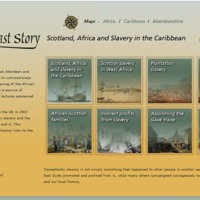
A North East Story: Scotland, Africa and Slavery in the Caribbean
This online exhibition and learning resource linking the history of transatlantic slavery to North East Scotland was organised by an Aberdeen and Aberdeenshire Bicentenary Committee, including representatives from Aberdeenshire Council, Aberdeen City Council, the University of Aberdeen, the Robert Gordon University and the African and African-Caribbean communities. It followed on from a service of commemoration and a series of public lectures sponsored by the Committee in 2007. The exhibition logo is inspired by the mythical Sankofa bird, a cultural symbol of the Akan-speaking peoples of Ghana in West Africa. Featured here are a number of resources available to download from the North East Story website.
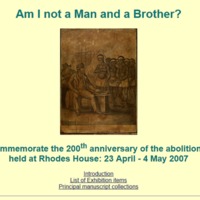
Am I Not a Man and a Brother?
‘Am I Not a Man and a Brother?’, an online exhibition to mark the bicentenary, was launched by the Bodleian Library of African and Commonwealth Studies at Rhodes House. Some of the items were also on view in an exhibition at Rhodes House in April and May 2007. The exhibition included manuscripts and books from the Library, among them the manuscript journal of Rev. James Ramsay, who wrote and worked against slavery after seeing for himself the conditions on board a slave ship while a Royal Navy surgeon. Also exhibited were related artefacts from the collection of Franklin Smith, including a tobacco jar and a clay pipe bowl, both in the shape of the head of a slave (indicating that their owners may have been slave owners), and the late 18th-century engraving of a slave market in the West Indies, published by an anti-slave trade body.
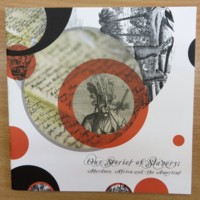
Our Stories of Slavery: Aberdeen, Africa and the Americas
The Our Stories of Slavery events programme ran from May to October 2007, co-ordinated by the Arts Development team at Aberdeen City Council. The project examined all aspects of Aberdeen's links with slavery and the transatlantic slave trade, including the role of Aberdonian landowners as slave owners, as well as the impact of Aberdonians as abolitionists, such as the roles played by James Beattie and James Ramsay.
One focus of the project was on the role of Aberdonian magistrates in kidnapping children from the City and Shire and selling them into indentured service to plantation owners during the 18th century. Peter Williamson, known as 'Indian Peter', was one of up to 700 kidnapped in Aberdeen between 1735 and 1750. The project used his story, with archives at the University of Aberdeen, in a range of activities including storytelling, re-enactments, film making, workshops, creative writing and craft workshops. Kidnapped was a re-enactment set in and around The Tolbooth (Aberdeen's Museum of Civic History). In collaboration with artist Chris Biddlecombe, community knitting circles created 'Cast-offs', exhibited at Aberdeen's Kirk of St Nicholas, whereby an installation of 600 knitted jumpers represented the abducted children.
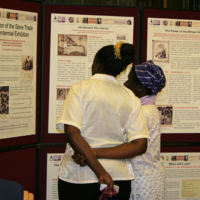
Abolition of the Slave Trade Bicentennial Exhibition
This exhibition held by the Cadbury Research Library: Special Collections at the University of Birmingham included material from the archives of the Church Missionary Society held there, and some of its rare book collections. The accompanying information boards are featured here. The exhibition focused on the role of religion in the abolitionist movement, the power of the African voice in literature, and the role played by Birmingham residents in the anti-slavery campaigns. A booklist on anti-slavery publications held at the library was also produced. The exhibition was part of a University-wide initiative, with additional involvement from academic departments and the Guild of Students. An online exhibition was also produced in collaboration with the Library of the Religious Society of Friends: 'Quakers and the path to abolition in Britain and the colonies'.
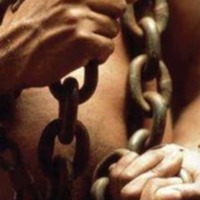
Bromley's Hidden History
‘Bromley’s Hidden History’ was led by Bromley Museum, with assistance from Bromley Local Studies and Archives. A touring exhibition, education pack, programme of events and web resources were produced to highlight Bromley’s connections with slavery and abolition. Bromley slave owners and those with capital invested in the Caribbean were highlighted, alongside the influence of William Pitt (who lived at Holwood House) and his political circle in the abolitionist campaign. Consideration was also given to historical black figures living in the borough, such as the actor Ira Aldridge.